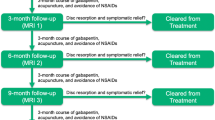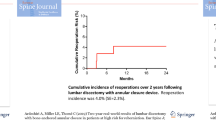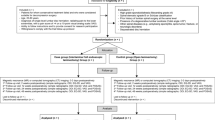Abstract
A prospective randomised 2-year follow-up study on patients undergoing lumbar disc herniation surgery. The objective was to investigate the relationship between peridural scarring and clinical outcome, the scar development 6 and 24 months postoperatively by using MRI, and if ADCON-L (a bioresorbable carbohydrate polymer gel) has an effect on scar size and/or improve patients’ outcome after lumbar disc herniation surgery. The association between peridural scarring and recurrent pain after lumbar disc herniation surgery is debated. Numerous materials have been used in attempts to prevent or reduce postoperative peridural scarring; however, there are conflicting data regarding the clinical effects. The study included 119 patients whose mean age was 39 years (18–66); 51 (47%) were women. Sixty patients (56%) were perioperatively randomised to receive ADCON-L, and 48 (44%) served as controls. All patients underwent MRI at 6 and 24 months postoperatively, and an independent radiologist graded the size, location and development of the scar, by using a previously described scoring system. Pre- and 2-year postoperatively patients graded their leg pain on a visual analogue scale (VAS). At the 2-year follow-up patients rated their satisfaction with treatment (subjective outcome) and were evaluated by an independent neurologist (objective outcome), using MacNab score. There was no relationship between size or localisation of the scar and any of the clinical outcomes (VAS, subjective and objective outcome). The scar size decreased between 6 and 24 months in 49%, was unchanged in 42% and increased in 9% of the patients. Patients treated with ADCON-L did not demonstrate any adverse effects, nor did they demonstrate less scarring or better clinical outcome than control patients. No significant association between the presence of extensive peridural scar or localisation of scar formation and clinical outcome could be detected in the present study. Further, no positive or negative effects of ADCON-L used in disc herniation surgery could be seen.





Similar content being viewed by others
References
Annertz M, Jonsson B, Stromqvist B et al (1995) Serial MRI in the early postoperative period after lumbar discectomy. Neuroradiology 37:177–182. doi:10.1007/BF01578253
Asch HL, Lewis PJ, Moreland DB et al (2002) Prospective multiple outcomes study of outpatient lumbar microdiscectomy: should 75 to 80% success rates be the norm? J Neurosurg 96:34–44
Babar S, Saifuddin A (2002) MRI of the post-discectomy lumbar spine. Clin Radiol 57:969–981. doi:10.1053/crad.2002.1071
Boden SD, Davis DO, Dina TS et al (1992) Contrast-enhanced MR imaging performed after successful lumbar disk surgery: prospective study. Radiology 182:59–64
Burton CV, Kirkaldy-Willis WH, Yong-Hing K et al (1981) Causes of failure of surgery on the lumbar spine. Clin Orthop Relat Res 157:191–199
Cervellini P, Curri D, Bernardi L et al (1988) Computed tomography after lumbar disc surgery: a comparison between symptomatic and asymptomatic patients. Acta Neurochir Suppl (Wien) 43:44–47
de Tribolet N, Porchet F, Lutz TW et al (1998) Clinical assessment of a novel antiadhesion barrier gel: prospective, randomized, multicenter, clinical trial of ADCON-L to inhibit postoperative peridural fibrosis and related symptoms after lumbar discectomy. Am J Orthop 27:111–120
Floris R, Spallone A, Aref TY et al (1997) Early postoperative MRI findings following surgery for herniated lumbar disc. Acta Neurochir (Wien) 139:169–175. doi:10.1007/BF01844746
Ganzer D, Giese K, Volker L et al (2003) Two-year results after lumbar microdiscectomy with and without prophylaxis of a peridural fibrosis using Adcon-L. Arch Orthop Trauma Surg 123:17–21
Grane P, Tullberg T, Rydberg J et al (1996) Postoperative lumbar MR imaging with contrast enhancement. Comparison between symptomatic and asymptomatic patients. Acta Radiol 37:366–372
Hieb LD, Stevens DL (2001) Spontaneous postoperative cerebrospinal fluid leaks following application of anti-adhesion barrier gel: case report and review of the literature. Spine 26:748–751. doi:10.1097/00007632-200104010-00009
Ivanic GM, Pink PT, Schneider F et al (2006) Prevention of epidural scarring after microdiscectomy: a randomized clinical trial comparing gel and expanded polytetrafluoroethylene membrane. Eur Spine J 15:1360–1366. doi:10.1007/s00586-006-0120-1
Jensen TT, Asmussen K, Berg-Hansen EM et al (1996) First-time operation for lumbar disc herniation with or without free fat transplantation. Prospective triple-blind randomized study with reference to clinical factors and enhanced computed tomographic scan 1 year after operation. Spine 21:1072–1076. doi:10.1097/00007632-199605010-00016
Kim KD, Wang JC, Robertson DP et al (2004) Reduction of leg pain and lower-extremity weakness for 1 year with Oxiplex/SP gel following laminectomy, laminotomy, and discectomy. Neurosurg Focus 17:ECP1. doi:10.3171/foc.2004.17.1.8
Kuhn J, Hofmann B, Knitelius HO et al (2005) Bilateral subdural haematomata and lumbar pseudomeningocele due to a chronic leakage of liquor cerebrospinalis after a lumbar discectomy with the application of ADCON-L gel. J Neurol Neurosurg Psychiatry 76:1031–1033. doi:10.1136/jnnp.2004.046276
Law JD, Lehman RA, Kirsch WM (1978) Reoperation after lumbar intervertebral disc surgery. J Neurosurg 48:259–263
Loupasis GA, Stamos K, Katonis PG et al (1999) Seven- to 20-year outcome of lumbar discectomy. Spine 24:2313–2317. doi:10.1097/00007632-199911150-00005
Macnab I (1973) Chapter 14. Pain and disability in degenerative disc disease. Clin Neurosurg 20:193–196
Maroon JC, Abla A, Bost J (1999) Association between peridural scar and persistent low back pain after lumbar discectomy. Neurol Res 21(Suppl 1):S43–S46
Nygaard OP, Kloster R, Dullerud R et al (1997) No association between peridural scar and outcome after lumbar microdiscectomy. Acta Neurochir (Wien) 139:1095–1100. doi:10.1007/BF01410967
Olmarker K, Storkson R, Berge OG (2002) Pathogenesis of sciatic pain: a study of spontaneous behavior in rats exposed to experimental disc herniation. Spine 27:1312–1317. doi:10.1097/00007632-200206150-00013
Ozer AF, Oktenoglu T, Sasani M et al (2006) Preserving the ligamentum flavum in lumbar discectomy: a new technique that prevents scar tissue formation in the first 6 months postsurgery. Neurosurgery 59:ONS126–ONS133. doi:10.1227/01.NEU.0000220078.90175.E6 (discussion ONS-33)
Richter HP, Kast E, Tomczak R et al (2001) Results of applying ADCON-L gel after lumbar discectomy: the German ADCON-L study. J Neurosurg 95:179–189
Ross JS (1999) MR imaging of the postoperative lumbar spine. Magn Reson Imaging Clin N Am 7:513–524
Ross JS, Robertson JT, Frederickson RC et al (1996) Association between peridural scar and recurrent radicular pain after lumbar discectomy: magnetic resonance evaluation. ADCON-L European Study Group. Neurosurgery 38:855–861. doi:10.1097/00006123-199604000-00053 (discussion 61–63)
Samy Abdou M, Hardy RW Jr (1999) Epidural fibrosis and the failed back surgery syndrome: history and physical findings. Neurol Res 21(Suppl 1):S5–S8
Schimizzi AL, Massie JB, Murphy M et al (2006) High-molecular-weight hyaluronan inhibits macrophage proliferation and cytokine release in the early wound of a preclinical postlaminectomy rat model. Spine J 6:550–556. doi:10.1016/j.spinee.2005.12.005
Spangfort EV (1972) The lumbar disc herniation. A computer-aided analysis of 2, 504 operations. Acta Orthop Scand Suppl 142:1–95
Tatsui CE, Martinez G, Li X et al (2006) Evaluation of DuraGen in preventing peridural fibrosis in rabbits. Invited submission from the joint section meeting on disorders of the spine and peripheral nerves, March 2005. J Neurosurg Spine 4:51–59. doi:10.3171/spi.2006.4.1.51
Vakis A, Koutentakis D, Karabetsos D et al (2006) Use of polytetrafluoroethylene dural substitute as adhesion preventive material during craniectomies. Clin Neurol Neurosurg 108:798–802. doi:10.1016/j.clineuro.2005.11.026
van de Kelft EJ, van Goethem JW, de La Porte C et al (1996) Early postoperative gadolinium-DTPA-enhanced MR imaging after successful lumbar discectomy. Br J Neurosurg 10:41–49. doi:10.1080/02688699650040511
Van Goethem JW, Van de Kelft E, Biltjes IG et al (1996) MRI after successful lumbar discectomy. Neuroradiology 38(Suppl 1):S90–S96. doi:10.1007/BF02278130
Vogelsang JP, Finkenstaedt M, Vogelsang M et al (1999) Recurrent pain after lumbar discectomy: the diagnostic value of peridural scar on MRI. Eur Spine J 8:475–479. doi:10.1007/s005860050208
Acknowledgments
The authors thank Gothenburg Medical Society, Doctor Felix Neubergh Foundation for financial support and government grants during LUA agreement. We also thank MD Lena Rutberg, neurologist, for the assessment of clinical outcome 2-year postoperative.
Author information
Authors and Affiliations
Corresponding author
Rights and permissions
About this article
Cite this article
Rönnberg, K., Lind, B., Zoega, B. et al. Peridural scar and its relation to clinical outcome: a randomised study on surgically treated lumbar disc herniation patients. Eur Spine J 17, 1714–1720 (2008). https://doi.org/10.1007/s00586-008-0805-8
Received:
Revised:
Accepted:
Published:
Issue Date:
DOI: https://doi.org/10.1007/s00586-008-0805-8




